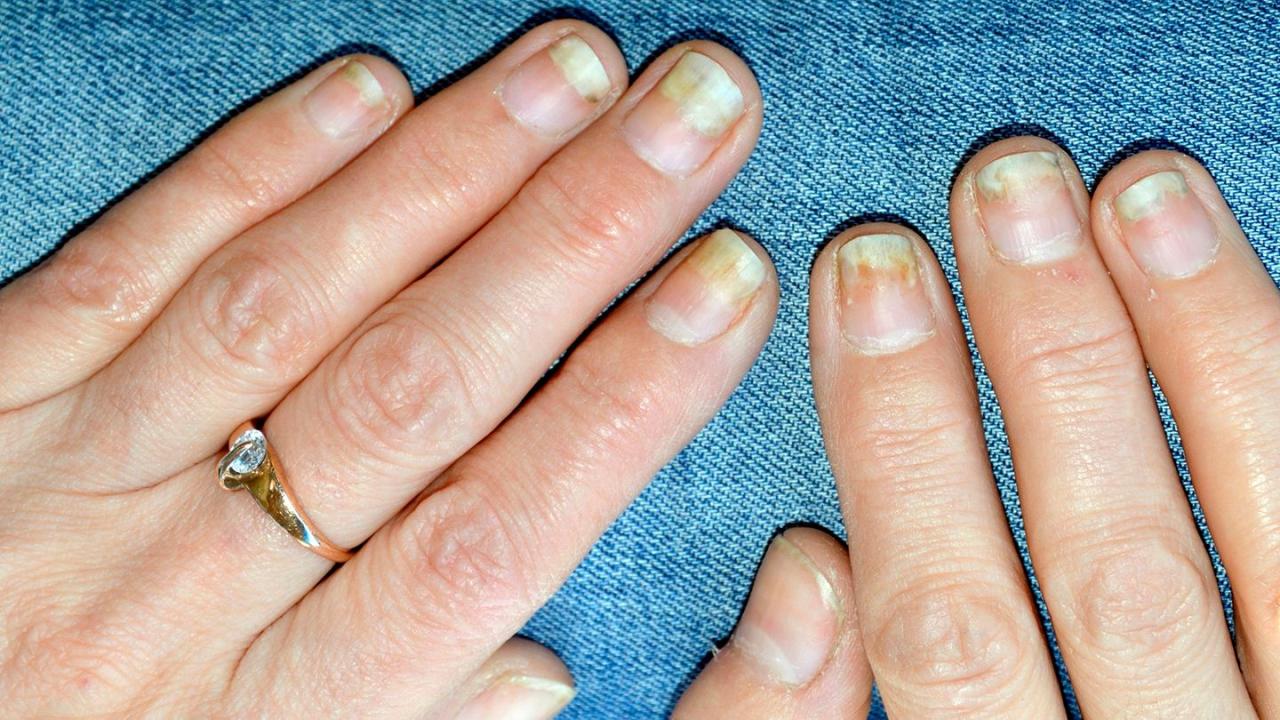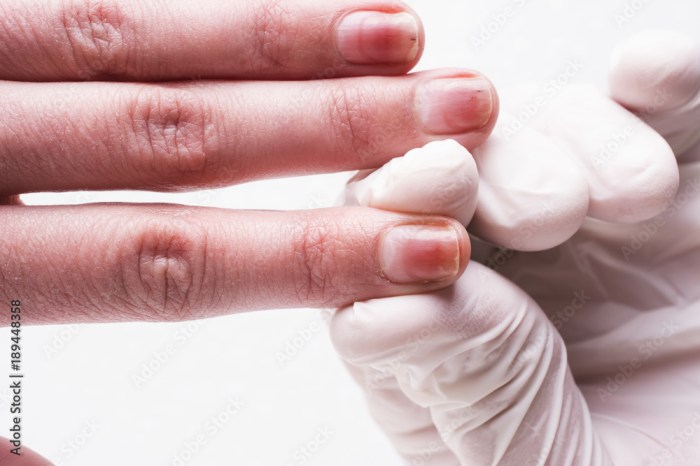Damaged Nails After Gel Polish A Comprehensive Guide
Causes of Damaged Nails After Gel Polish Removal
Damaged nails after gel polish – Gel manicures offer a long-lasting, polished look, but improper removal can lead to significant nail damage. This damage stems from a combination of chemical and physical processes involved in the removal procedure, as well as pre-existing nail conditions and application frequency.
Chemical Processes in Gel Polish Removal
The primary culprit in gel polish removal is acetone, a strong solvent that dissolves the gel. Prolonged exposure to acetone can dry out the nails, making them brittle and prone to breakage. The chemical process weakens the nail plate’s natural protective layers, leaving it vulnerable to damage.
Physical Actions During Removal
Aggressive filing or scraping during removal can also cause significant damage. Excessive force can thin the nail plate, leading to weakening and peeling. Improper use of tools, such as metal pushers or overly rough files, can cause micro-tears and trauma to the nail bed.
Comparison of Gel Polish Removal Methods
Different removal methods have varying degrees of impact on nail health. Soaking in acetone is generally gentler than filing, although prolonged soaking can still cause dryness. Filing, especially with an e-file, carries a higher risk of over-thinning and damage if not performed carefully by a trained professional. Manual removal with a wooden cuticle pusher and acetone is often considered a compromise between the two, requiring patience but minimizing the risk of over-thinning.
Factors Exacerbating Nail Damage
Several factors can worsen nail damage after gel polish removal. Pre-existing conditions like thin or brittle nails increase vulnerability. Frequent gel polish applications, without adequate recovery time between treatments, also contribute to cumulative damage. Underlying health issues, such as nutritional deficiencies, can also weaken nails.
Comparison of Removal Methods’ Effects on Nail Health
| Removal Method | Dryness | Thinning | Brittleness | Overall Impact |
|---|---|---|---|---|
| Acetone Soaking | High | Low to Moderate | Moderate | Moderate |
| E-file Removal | Low | High | High | High (if improperly performed) |
| Manual Removal | Moderate | Low | Low | Low |
Recognizing and Identifying Nail Damage
Recognizing the signs of nail damage is crucial for effective treatment. Various visual cues, ranging from subtle changes in texture to significant structural alterations, indicate the extent and type of damage.
Visual Signs of Damaged Nails
Damaged nails may exhibit brittleness, leading to easy breakage. Thinning of the nail plate is another common sign, often accompanied by a noticeable decrease in nail thickness. Discoloration, ranging from yellowish hues to white spots, can also indicate damage. Peeling or lifting of the nail from the nail bed (onycholysis) is a more severe sign.
Levels of Nail Damage
Mild damage might involve minor brittleness or slight discoloration. Moderate damage includes noticeable thinning, peeling, and increased breakage. Severe damage often involves significant thinning, delamination (separation of nail layers), and potentially underlying nail bed issues.
Types of Nail Damage
Delamination refers to the separation of nail layers, creating a weak and fragile nail. Onychorrhexis describes brittle, ridged nails prone to splitting. Onycholysis is the separation of the nail plate from the nail bed.
Examples of Nail Damage
A mildly damaged nail might appear slightly thinner and more brittle than usual, with subtle vertical ridges. Moderately damaged nails might show significant thinning, peeling at the edges, and noticeable discoloration. Severely damaged nails could be extremely thin, exhibiting significant delamination, and possibly showing signs of infection.
Visual Guide to Nail Damage (Descriptive), Damaged nails after gel polish

Source: everydayhealth.com
Frequently, removing gel polish can leave nails brittle and damaged. This damage is often exacerbated by improper removal techniques. Before considering further applications, it’s crucial to understand the potential impact, especially if you’re considering reapplying polish; the question of whether you can you put gel polish on fungal nail is particularly relevant. Addressing underlying nail health is key to preventing further damage after gel polish removal.
Mild Damage: Imagine a nail that’s slightly less shiny than usual, with subtle vertical lines and a slightly softer texture. The color remains largely unchanged.
Moderate Damage: Picture a nail that’s noticeably thinner, with peeling edges and perhaps some slight discoloration, like a faint yellowing. The texture is rougher and less smooth.
Severe Damage: Envision a nail that’s paper-thin, with significant separation of layers (delamination).
The color might be uneven or discolored, and the nail may be easily broken or deformed.
Treatment and Repair of Damaged Nails
Treating damaged nails involves a multi-pronged approach, ranging from simple home remedies for mild cases to professional interventions for more severe damage. The goal is to restore nail health and prevent further deterioration.
Treating Mildly Damaged Nails at Home
1. Gently buff the nail surface with a fine-grit buffer to remove any rough edges or ridges.
2. Apply a nourishing cuticle oil daily to moisturize and strengthen the nails.
3.
Use a nail strengthener containing ingredients like keratin or biotin to improve nail resilience.
4. Avoid harsh chemicals and prolonged exposure to water.
Professional Treatments for Moderate to Severe Nail Damage
For moderate to severe damage, professional treatments are often necessary. Nail strengthening products applied by a professional can provide a more robust protective layer. Nail wraps can temporarily strengthen and protect the damaged nail until it regrows.
Comparison of Nail Strengthening Products
Nail strengtheners vary in their formulations and effectiveness. Some contain keratin to reinforce the nail’s protein structure, while others incorporate vitamins and minerals to promote growth. Choosing a product that addresses specific nail concerns (e.g., brittleness, peeling) is essential.
Recommended Ingredients for DIY Nail Repair
Keratin, biotin, vitamin E, jojoba oil, and argan oil are commonly used ingredients in nail strengthening treatments. These ingredients provide hydration, nourishment, and structural support.
Creating a Protective Barrier for Damaged Nails
Applying a base coat before any nail polish acts as a protective barrier, preventing further damage. A high-quality nail strengthener, applied as a base coat, can offer additional reinforcement and hydration.
Prevention of Future Nail Damage
Preventing future nail damage requires a proactive approach, focusing on proper nail care and minimizing the risk factors associated with gel polish applications.
Preparing Nails Before Gel Polish Application
Proper nail preparation is crucial. Avoid excessive filing or buffing, and ensure the nail surface is clean and dry before applying the gel polish.
Proper Application and Removal Techniques
Using proper application and removal techniques is essential. Avoid aggressive filing or scraping during removal. Opt for gentle soaking methods and use a low-grit file only when necessary.
Benefits of Nail Strengtheners and Cuticle Oils
Regular use of nail strengtheners and cuticle oils helps to maintain nail health and prevent brittleness. These products provide hydration, nourishment, and structural support.
Impact of Diet and Overall Health
A balanced diet rich in protein, vitamins, and minerals is crucial for strong, healthy nails. Underlying health issues can significantly impact nail health, so addressing any health concerns is important.
Checklist for Maintaining Healthy Nails
- Avoid over-filing or buffing.
- Use a gentle acetone-based remover.
- Apply a base coat before gel polish.
- Use a top coat for protection.
- Moisturize nails and cuticles regularly.
- Take breaks between gel manicures.
- Maintain a healthy diet.
Alternative Nail Enhancements: Damaged Nails After Gel Polish

Source: ftcdn.net
Gel polish is not the only nail enhancement option available. Acrylics and dip powder are alternatives, each with its own set of advantages and disadvantages.
Comparison of Nail Enhancement Options
Acrylics offer durability but can be harsh on natural nails if improperly applied or removed. Dip powder provides a similar long-lasting finish but might be slightly less damaging than acrylics. Both require professional removal to minimize damage.
Potential Benefits and Drawbacks of Alternatives
Acrylics offer excellent durability and a wide range of design possibilities, but improper application can lead to significant nail damage. Dip powder is generally less damaging than acrylics, offering a longer-lasting manicure with less risk of lifting. However, it can still dry out the nails if not properly maintained.
Long-Term Effects on Nail Health
The long-term effects of any nail enhancement depend on application and removal techniques, as well as the individual’s nail health. Proper application and removal by a trained professional are crucial for minimizing long-term damage.
Comparison of Cost, Longevity, and Nail Health Impact
| Method | Cost | Longevity | Nail Health Impact |
|---|---|---|---|
| Gel Polish | Moderate | 2-3 weeks | Low to Moderate (with proper removal) |
| Acrylics | High | 4-6 weeks | Moderate to High (if improperly applied/removed) |
| Dip Powder | High | 3-4 weeks | Low to Moderate (with proper removal) |
Helpful Answers
Can I use nail polish remover to remove gel polish?
No, regular nail polish remover won’t effectively remove gel polish. Gel polish requires specialized removers containing acetone.
How often should I remove gel polish?
It’s recommended to remove gel polish every 2-3 weeks to allow your nails to breathe and avoid excessive damage.
What are the signs of a nail infection after gel polish removal?
Signs of infection include increased pain, redness, swelling, pus, or a noticeable change in nail color or texture. Consult a doctor if you suspect an infection.
Are there any natural remedies for damaged nails?
Yes, applying cuticle oil regularly, consuming a healthy diet rich in biotin and protein, and using strengthening nail treatments can help.















